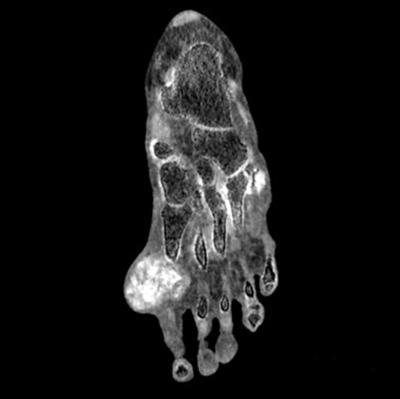Sept. 28, 2018
McCaig Institute researcher takes the guesswork out of gout

Gout has been called “the king of diseases and the disease of kings” because of its link to the consumption of rich foods and good ale. But for Shannon Pelley, above, it’s just a royal pain in the… foot.
Gout is a type of inflammatory arthritis caused by small crystals of uric acid accumulating in joints, causing swelling and inflammation. This happens when a person’s body produces too much uric acid, or the body is unable to dispose of the uric acid it produces. Gout is the most common inflammatory arthritis in men older than 40 and it is under-recognized in post-menopausal women, affecting about five to seven per cent of the Canadian population. Despite the availability of effective medication, it is the most poorly managed and under-treated rheumatic disease in North America.
A pain in the foot
Pelley was coaching his daughter’s soccer practice when he stubbed his toe. “It started to ache, and didn’t feel right. I injured that foot several years earlier, so I thought it was just related to that,” he says. “Or I thought maybe I broke the toe.”
He tried icing and resting his foot but nothing seemed to help. A few days later he woke up in the middle of the night with a pulsating, excruciating pain in his foot. “I could barely walk the next day,” he says. “It felt like someone was poking a knife in my foot.”
Pelley visited a podiatrist who ordered an ultrasound, which showed inflammation and fluid in the joint of his big toe. After reviewing his symptoms, the doctor diagnosed Pelley with gout. The pain lasted for months, with Pelley having to give up many of the activities he loves, including hockey. “My foot was so swollen and painful, I couldn’t even lace up my skates.”

Rheumatologist and McCaig Institute researcher Paul MacMullan is taking the guesswork out of gout.
Crystal-clear diagnosis
“Gout is essentially curable,” says Calgary rheumatologist and researcher at the Cumming School of Medicine’s McCaig Institute, Dr. Paul MacMullan, MD. “There are several medications available that are really good at controlling the disease. The problem is a lot of cases of gout are misdiagnosed as a joint injury or cellulitis or another form arthritis.”
Early, accurate diagnosis and proper treatment are key. If left untreated, gout can cause permanent damage to affected joints. Blood tests and imaging can sometimes detect uric acid crystals in affected joints, but these tests are not always accurate. “By the time gout can be detected by X-ray, the disease has progressed pretty far,” says the clinical assistant professor in the Department of Medicine.
A definitive diagnosis involves inserting a needle into the affected area to take a sample of fluid. Often, this procedure isn’t performed due to a lack of availability or expertise. Also, none of the existing diagnostic tools accurately assesses the amount, or load, of uric acid present in a joint — an important piece of information for physicians to determine the best treatment.
“By the time patients come to see me, most have a significant burden of urate crystal deposition that has been previously unrecognized,” says MacMullan.
He is looking for a less invasive way to reliably test for gout. He is using an exciting, new technology called dual-energy computed tomography (DECT) to image uric acid deposits in joints. DECT uses both a normal X-ray and a second, less powerful X-ray to create detailed, cross-sectional images of the body. Most standard CT scanners have DECT capabilities, but lack the software to accurately detect uric acid crystals. MacMullan and colleagues have developed new computational analysis and measurement software that will allow DECT to differentiate uric acid crystals from bone, allowing radiologists to quantify the amount of uric acid in a joint.

A dual-energy computed tomography image of uric acid crystals.
A dual-energy computed tomography image of uric acid crystals.
“Our hope is that once we establish the correct protocol we can patent the software, and DECT will become the new non-invasive gold standard for physicians to quantify how much uric acid is deposited within, or around, a joint,” says MacMullan. “Ultimately, we want to provide the best, targeted treatment for patients.”
That’s good news for people like Pelley, who hasn’t had a flare-up of his gout in three years. “I’ve been lucky so far, but I’m always wondering if and when the pain will return,” he says. “I’m not looking forward to that day.”
You can learn more about Paul MacMullan’s gout study and other foot and ankle research at this year’s Wood Forum on Foot and Ankle Health, Oct. 27 at the Red and White Club. Register here to attend.
Paul MacMullan is a rheumatologist, a member of the McCaig Institute for Bone and Joint Health, and a clinical associate professor in the Department of Medicine, Cumming School of Medicine at the University of Calgary. This study was initiated through an Encore Catalyst Grant, with money raised by the 2015 Encore: Music in Motion concert. MacMullan’s work is also funded by the Canadian Institutes of Health Research.
